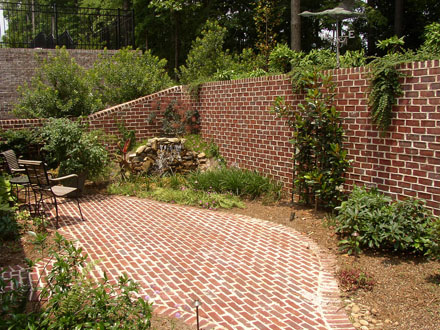by Shawn Kyles
 Retaining walls are stabilizing structures built to stop erosion and the downward movement of soil on a slope. The walls are built in a way that redistributes the pressure that comes from the sloping ground. A variety of materials are used to build the walls, such as concrete, steel, stone, brick, composites, wood and even glass.
Retaining walls are stabilizing structures built to stop erosion and the downward movement of soil on a slope. The walls are built in a way that redistributes the pressure that comes from the sloping ground. A variety of materials are used to build the walls, such as concrete, steel, stone, brick, composites, wood and even glass.
Retaining walls on residential properties are often constructed to hold back the soil from a hillside, many times to create more usable space. Other uses for a retaining wall include stopping soil from sliding away from a foundation or from damaging the landscape.
There are various kinds of retaining walls, including gravity walls, anchored walls, cantilevers and sheet pile walls.
Gravity restraining walls depend on their own significant weight to keep soil from moving. They are constructed leaning backwards toward the soil. Early gravity walls were built from concrete or stone. Today, they are made from many different types of materials, including steel wire baskets filled with rocks and geosynthetics.
Anchored walls are restraining walls constructed using cables (usually extremely strong steel) that are anchored into the soil or rock behind the wall. They are used when the wall cannot be built strong enough to restrain the load. Constructing an anchored wall is an extremely complex process.
Cantilever walls are used to hold back a large amount of soil. They are made with steel-reinforced concrete that rest on slab foundation. Cantilever walls convert horizontal pressures from the soil to vertical pressures on the ground.
Sheet piling walls, which can be made from wood, vinyl or steel planks, are used in places where the space is tight and the soil is soft. The planks are driven into the ground.
Determining what type of retaining wall construction to use will depend on the type of soil that needs to be retained, the kind of soil the wall will be built on, how much space is available for the wall and the degree of slope above and below the structure. The location of pipes and service lines can also be a factor in construction.
Deciding what material to use will also be based on the environment, as well as budget and preferences regarding color and texture. Large retaining walls will require strong and durable materials.
Another important issue for retaining walls is drainage. Choosing the best method of drainage will increase the strength of the wall. The wrong type of drainage can result in the walls eventual collapse. Sometimes proper drainage can be easily accomplished by simply creating holes in the wall. However, the structure can easily become damaged if the holes get clogged.
The best way to ensure your wall is built right, is to hire a professional foundation contractor who has experience constructing retaining walls on many different types of properties. A knowledgeable builder will evaluate every aspect of the project. You will get reliable advice regarding your options, which can save you considerable time and money. You will also have peace of mind knowing that your wall is sturdy and long-lasting.
No comments:
Post a Comment